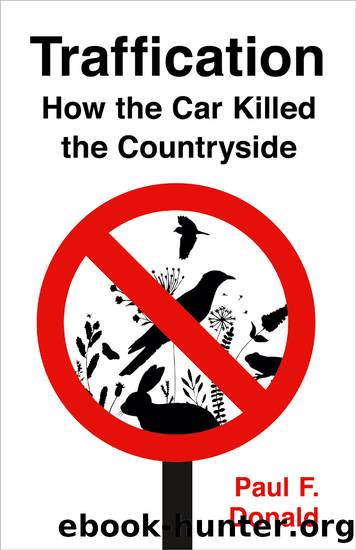Traffication by Donald Paul;

Author:Donald, Paul;
Language: eng
Format: epub
Publisher: Pelagic Publishing
The anthropause
The second strand of evidence we can use to assess the impacts of traffication on the abundance of animals comes from studies that examine those rare situations in which road traffic changes but everything else, such as agriculture and climate, stays exactly the same. Evidence like this has proved compelling in proving a causal link between threats such as agricultural intensification or invasive species and declines in biodiversity â reverse them by changing how land is farmed, or by eradicating pest species, and the native wildlife usually recovers.
In the case of traffication, evidence of this type is rare, for obvious reasons. It would be scientifically wonderful, although of course massively inconvenient to millions of people, to close some motorways for a few years and see how the wildlife in the surrounding landscape responds, but that is unlikely ever to happen. Such evidence in the field of road ecology is therefore largely opportunistic. There are not many examples, and none that I can find from Britain, but the few studies that exist are all entirely consistent with the existence of a wide road-effect zone.
A study carried out in Spain, for instance, looked at how birds of prey changed their distribution in response to changes in traffic flow along a major road. At weekends, when the number of vehicles more than doubled compared with weekday traffic flow, vultures and eagles moved significantly further away from the road to feed and roost â a considerable area around the road was effectively lost to them. The researchers chose their study site well: the road was not used by pedestrians, and all the surrounding land was privately owned, so the results could not have been caused by a weekend influx of people moving about outside cars. Similar results come from Canada, where the closure of a popular road in Banff National Park during the hours of darkness allowed grizzly bears and other mammals to feed closer to the highway at night than they had done previously.
But the greatest unplanned experiment of all time was that which descended upon humanity in early 2020. The COVID-19 pandemic and the lockdowns put in place to control its spread led to the first major reduction in road traffic since the Second World War. The world went into what has been called an anthropause, a temporary relaxation of the pressures we place on the environment. Highways and motorways briefly fell silent, as traffic dropped to levels not seen since the 1950s. This gave scientists a unique opportunity to see what happens when traffic is reduced over huge areas. Birds and frogs immediately changed their songs. Roadkill rates plummeted. And using millions of observations of birds submitted by volunteers, researchers in Canada and the USA were able to show that many bird species that normally avoid roads were found in significantly higher numbers near them during lockdown than in previous, non-lockdown years. A single spring of calm is not long enough to make much difference to the overall populations of
Download
This site does not store any files on its server. We only index and link to content provided by other sites. Please contact the content providers to delete copyright contents if any and email us, we'll remove relevant links or contents immediately.
Nudge - Improving Decisions about Health, Wealth, and Happiness by Thaler Sunstein(6644)
iGen by Jean M. Twenge(4708)
The Fire Next Time by James Baldwin(4352)
Adulting by Kelly Williams Brown(3682)
The Sports Rules Book by Human Kinetics(3597)
The Hacking of the American Mind by Robert H. Lustig(3589)
The Ethical Slut by Janet W. Hardy(3513)
Captivate by Vanessa Van Edwards(3310)
Mummy Knew by Lisa James(3176)
In a Sunburned Country by Bill Bryson(2954)
The Worm at the Core by Sheldon Solomon(2929)
Ants Among Elephants by Sujatha Gidla(2929)
Suicide: A Study in Sociology by Emile Durkheim(2617)
The Slow Fix: Solve Problems, Work Smarter, and Live Better In a World Addicted to Speed by Carl Honore(2579)
Humans of New York by Brandon Stanton(2383)
Handbook of Forensic Sociology and Psychology by Stephen J. Morewitz & Mark L. Goldstein(2380)
Blackwell Companion to Sociology, The by Judith R. Blau(2320)
The Happy Hooker by Xaviera Hollander(2277)
Outliers by Malcolm Gladwell(2263)
